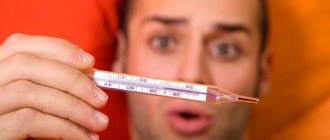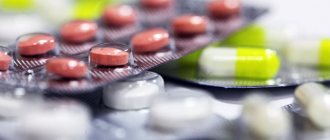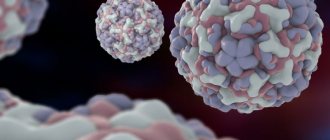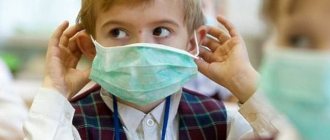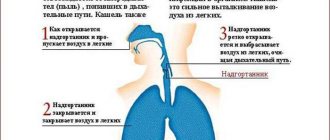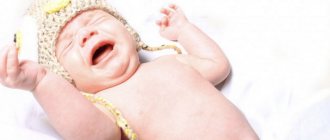What you need to know about high fever
If you measure the temperature in the armpit of a child immediately after birth, the readings will be slightly elevated (relative to the standard). The thermometer will show 37-37.4°C. This is not a deviation. After a few months, the child’s body temperature returns to normal and is 36-37°C. From this point on, any increase over 37°C is considered pathological.
It is important to emphasize that elevated temperature in children itself is not a disease. This is the immune system's response to an injury or infection that has entered the body.
The thermoregulation center located in the hypothalamus (a part of the brain) is responsible for maintaining body temperature at a constant level. A healthy person has a normal temperature in the range of 36.5-37.5°C. Pathogenic fungi, bacteria and viruses, when they enter the body, affect all systems, including the hypothalamus. In response to this effect, the thermoregulatory center increases body temperature. Under these conditions, pathogens cannot exist and gradually die.
The restoration of normal temperature indicators occurs after the complete elimination of pathogenic microorganisms.
In medicine, it is customary to divide elevated temperature into several types:
- Subfebrile. This fever is accompanied by a rise in temperature no higher than 38°C.
- Febrile. This includes indicators within 38-39°C.
- Heat. The thermometer shows from 39 to 41°C.
- Hyperthermic - above 41°C.
Low-grade fever: what is it and how to recognize it
Are you sure that your child has a sudden fever? Please know that this does not always happen. It often happens that the baby feels well, plays cheerfully and eats with appetite, but a random measurement suddenly shows a level above normal. It is likely that the baby’s body degree has been in the range of 37-38° for a long time.
This may signal the presence of diseases that are hidden, and it is necessary to do a series of laboratory tests, after which the doctor will be able to make a diagnosis.
Depending on the results, consultations with specialists of various profiles may be required. Only a thorough examination can reveal the cause of low-grade fever.
This may be a consequence:
- decreased immunity;
- disturbances in the process of thermoregulation of the body;
- the presence in the body of viral or bacterial diseases that are asymptomatic.
If, as a result of all laboratory tests, no hidden infections were found, then attention should be paid to increasing children's immunity. It can rise quite quickly if you walk in the fresh air more often and longer, and make sure that your baby is properly fed. It is also important that the child sleeps well; sound and healthy sleep is the key to health. If all measures are followed, you can quickly return to normal temperature readings.
Causes of fever in children
There are several reasons for an increase in body temperature in a child:
- infectious diseases;
- overheating;
- teething;
- poisoning;
- helminthic infestation;
- psycho-emotional shock;
- reaction to vaccinations;
- tumors.
After a routine vaccination, there is a risk of an increase in the child’s temperature - the reason here is the body’s reaction to the administered drug. Most often, fever appears after vaccines against measles, mumps and rubella. Doctors warn parents about such symptoms in advance. In most cases, the reaction occurs within the next 3-4 days. The fever lasts for several days, but in some cases the symptoms persist for up to 10 days.
Worm infestation is also sometimes accompanied by fever, abdominal pain and stool disorders. Antibiotics and antiviral drugs will be powerless. A thorough examination and treatment for parasites is necessary.
We cannot exclude the influence of the psycho-emotional background on the health and condition of children. A nervous shock, for example, a quarrel between parents or a conflict with peers, often leads to a child with a fever.
Overheating
The absence of other pronounced symptoms of a painful condition may indicate overheating. This happens in children of any age.
Many parents are afraid of their babies catching a cold, so they dress them warmer than necessary. However, in children under one year of age, the thermoregulation center is not configured in the same way as in adults, so any overheating quickly causes an increase in body temperature to 39°C and above. In such cases, the main requirement is to undress the child and allow the body to recover on its own.
At older ages, causeless fever in children is often caused by prolonged exposure to the sun. To bring the condition back to normal, the baby needs to be cooled as soon as possible. There are several ways to do this:
- take it to a shaded, cool place;
- apply a cold compress to the forehead (using a wet towel);
- give cool water to drink.
After such actions, the child’s fever will gradually subside.
Temperature during teething
At a young age, fever in children under one year of age may occur due to teething. Among the symptoms that accompany this phenomenon, in addition to fever:
- bloating;
- bowel dysfunction;
- redness and swelling of the gums;
- decreased appetite;
- fatigue, tearfulness;
- Some children urinate more frequently.
During teething, the child's immunity decreases, so the body is susceptible to bacteria and viruses. To protect the baby as much as possible, parents should closely monitor his condition. Hypothermia must not be allowed.
In some cases, redness of the throat and a slight cough may appear during this period. However, these symptoms do not always mean a sore throat or infection. Parents should not give their children antibiotics or other strong drugs without consulting a doctor. If your baby has a high temperature, you can give an antipyretic. In most cases, symptoms persist for 2-3 days, after which the condition stabilizes.
Infectious diseases
If a child has a fever, this is most often due to an infection entering the body. The localization of the inflammatory process can be determined using the symptoms that develop, including fever.
Tonsillitis (tonsillitis). Acute tonsillitis is usually understood as inflammation of the lymphatic pharyngeal ring (most often the tonsils). Externally, tonsillitis manifests itself as local redness of the throat and pain in this area.
The causative agents of sore throat are viruses and bacteria. In addition to fever and sore throat, the following symptoms may occur:
- cough;
- sneezing;
- runny nose;
- lack of appetite;
- lethargy and drowsiness.
ARVI (acute respiratory viral infection). This diagnosis in children is accompanied by symptoms:
- elevated temperature (in most cases the thermometer shows no higher than 37.5°C);
- sneezing;
- headache;
- nasal congestion;
- decreased sense of smell.
Sinusitis, which is an inflammation of the sinuses, has similar symptoms. This disease requires timely proper treatment, including antibiotics. In order to detect pathology in time, you should not delay contacting a pediatrician.
Inflammation of internal organs. Pyelonephritis (inflammation of the kidneys), pancreatitis (inflammation of the pancreas), appendicitis can be suspected when abdominal pain, a sharp increase in temperature and chills occur. In this case, you should immediately contact your pediatrician and surgeon.
Inflammation of the bladder has many symptoms similar to inflammatory diseases of the internal organs. In addition to fever (up to 38°C) and pain in the abdominal cavity, frequent urination and pain in the lower abdomen appear.
An intestinal infection is accompanied by fever, abdominal pain, diarrhea, nausea and vomiting. In these cases, taking an antipyretic will not give the desired effect. After a few hours the temperature will rise again. Treatment should be aimed at eliminating the cause.
Stomatitis (inflammatory disease of the oral mucosa). This disorder is caused by pathological bacteria, viruses and fungi. When examining the child’s oral cavity, redness of the gums, tongue and inner surface of the lips, and small ulcerative rashes are detected. In this case, there is fever, lack of appetite, and painful sensations.
Bronchitis (inflammation of the bronchi). This diagnosis can be signaled by a low temperature (about 38°C), cough and chest pain.
Pneumonia (pneumonia). Suspicion of pathology arises when several symptoms are present:
- cough (at the beginning of the disease it is light and dry, but later it becomes more pronounced and wet);
- temperature (in most cases above 39°C);
- attacks of nausea;
- headache;
- weakness, increased fatigue, drowsiness.
For pneumonia, it is important to start treatment in the first days, as there is a high risk of complications that are extremely dangerous for the child’s life.
Meningitis (inflammation of the tissues of the brain and spinal cord). This is an extremely dangerous disease in children, the symptoms of which are:
- elevated temperature;
- headache;
- frequent bouts of vomiting.
It is extremely difficult to do without medical help, since the consequences of the disease can lead to intellectual impairment, paralysis, deafness and blindness.
Often, without tests and diagnostics, it is difficult to determine the cause of a high temperature in a child 3 years old and older, so it is better not to delay a visit to the doctor.
Causes of fever in a child
Possible causes of a sudden increase in temperature may include a virus, overheating in the sun, or teething.
There are a large number of diseases that can cause unexpected fever:
- Flu (sometimes its symptoms appear later);
- Kidney infection;
- Chickenpox (may appear a few days after the temperature rises);
- Intestinal infection;
- Meningitis.
Let's look at each of the reasons in more detail.
When a fever becomes life-threatening
With proper functioning of the thermoregulation center, the human body temperature cannot rise above 41-42°C. This is explained by the fact that intense heat is destructive not only to viruses and bacteria, but also to the body’s own cells. So, when the thermometer reaches 42°C, protein is destroyed, and it is the main building material for cells and tissues. Over the years of evolution, the body has “learned” not to exceed this threshold. An exception occurs if a person has damage to the hypothalamus as a result of injury or tumor.
Pediatricians emphasize that in some cases, even a slight increase in temperature can cause serious complications in a child. This happens when:
- lesions of the central nervous system;
- disorders of the cardiovascular system.
With such diagnoses, it is important for parents to remember what temperature is dangerous for the child and how to bring it down as quickly as possible.
Teething: symptoms and actions of parents
In the vast majority of cases, the provoking factor for a rise in temperature without other clinical manifestations is teething.
Symptoms that may indicate this:
- the age of the baby ranges from five months to two years;
- the baby tries to scratch his gums, puts everything he finds into his mouth;
- the thermometer shows values of about 38°C, but no more;
- the baby’s gums are inflamed, you can see the edge of an erupting tooth;
- one to three days after tooth eruption, the temperature decreases;
- When teething, the baby's temperature also increased in the same way.
There are some other symptoms by which parents can determine that the toddler is teething: he refuses food, and there is increased salivation. However, such signs are quite controversial.
Increased secretion of saliva is observed already in two-month-old infants, when teething is still far away. At such a time, the salivary glands simply begin to work intensively. If we talk about the deterioration of appetite, then you don’t want to eat it precisely because of the high temperature.
What you can do:
- To relieve sore gums, you can resort to special gels.
- Give your child more to drink.
- From time to time, ventilate the room well (when the baby is not in it), make sure that the room temperature does not rise above 22°C.
- You should not walk or bathe your child if the temperature has risen above 37.5°C; it is better if the baby stays at home and gets more rest.
- If a high temperature is accompanied by whims or, on the contrary, lethargy, then you should give the child an antipyretic medicine - it will relieve pain, itching and have a calming effect.
how to reduce a child's fever without medication
When should you measure your temperature?
Most often, parents take their children's temperature when their forehead is hotter than usual. If the child’s general condition and behavior have not changed, then even if there is a fever, the medicine should not be given. To begin with, you should calm the baby down, sit him down in a cool, well-ventilated room, undress him and give him water. Perhaps a hot forehead is a sign of overheating.
Doctors recommend giving children a thermometer if symptoms such as:
- lethargy;
- cough;
- runny nose;
- lack of appetite;
- vomit;
- pain (headache, epigastric).
What to do when a child has a high temperature should be decided taking into account the signs of the disease. After first aid is provided, a pediatrician is called to the home.
In what cases should you call emergency medical care?
Call an ambulance immediately if, after your baby has taken an antipyretic, his temperature does not drop, he is too lethargic, his skin turns pale, or he has difficulty breathing.
If seizures occur, intracranial pressure must be checked. In most cases, the outcome is favorable, and this is how the body reacts to a sharp rise in temperature, but all risks must still be excluded.
It is extremely important for parents to be prepared for a possible increase in the baby’s temperature. You should consult your pediatrician in advance so that he can tell you what medications you can use, and always have them in your medicine cabinet at home.
how to reduce a child's temperature at home
How to measure temperature correctly
To obtain the most accurate results, it is important to use the thermometer correctly. If you use a mercury thermometer, then you need to follow several recommendations:
- During measurement, children should be calm and in a sitting or lying position.
- The armpit should be dry.
- Before use, check the thermometer readings. The column should be below 36.6°C. If the reading is higher, shake the thermometer until the desired value is obtained.
- It is necessary to place the device under the armpit in such a way that the tapered tip filled with mercury is completely immersed in the skin fold.
- To obtain a reliable result, you need to hold the thermometer for at least 7-10 minutes.
There are other thermometers that can determine the presence of fever in children:
- Electronic. When the indicator reaches the desired level, the thermometer emits a sound signal.
- Contactless. Please read the instructions carefully before use.
- Rectal (installed in the rectum). When using such a device, it is necessary to take into account that the temperature is considered elevated from 38°C.
- Oral (installed in the mouth under the tongue). Indicators up to 37.8°C are considered normal.
For young children, it is most convenient to use non-contact or electronic thermometers. The latter are safe even if the device is damaged (unlike mercury). The temperature of a child 5 years and older can be measured by any of the following methods.
Basic actions on the part of parents
If a child develops a fever without symptoms, parents should have a clear idea of what actions they should take. Many people know that temperature changes are the body’s fight against pathological processes. It is necessary to take into account how high it is, and based on this, take certain measures. Let's take a closer look at the actions taken by parents in the table.
Table 1
| Body temperature indicators | Parents' actions |
| 37.0 – 37.5 | A temperature of 37 indicates an independent struggle of the body, which does not require drug intervention and that it must be brought down. |
| 37.5 – 38.5 | It is necessary to wipe the child with a damp cloth at a temperature of 38, especially the arms and legs, ventilate the room, the child needs to drink as much as possible. |
| 38.5 and above | 39 in a child without symptoms implies the use of antipyretic drugs (Panadol or Nurofen), which is important to consider. If the temperature begins to noticeably decrease and then rises again, while the legs are cold, then this indicates the presence of a viral infection in the body, for example, rubella, measles, or the like is possible with chickenpox. In this case, you should call a specialist to your home. |
Parents' actions when the temperature rises
Fever in children requires an immediate reaction from parents, but one should not panic. There are several rules that will help stabilize the baby’s condition and relieve fever:
- In the room, it is important to maintain the air temperature within +18…+22C° and ensure a flow of fresh air. You can ventilate the room, but without drafts.
- Regular fluid intake is necessary. At elevated temperatures, children need to drink about 100 ml of liquid per kg of weight per day. It can be water, sweet tea, compote, fruit drink, rosehip decoction - any drink at room temperature or a little warmer. In this case, the liquid is absorbed faster in the body. It is better to give drinks little by little, but often. Infants should be placed to the breast periodically and given a small amount of water.
- If a child has a high temperature, then there is no need to dress and wrap the baby. He is left wearing a loose undershirt or T-shirt, socks and panties. It is better to avoid diapers during this period. If your baby feels chilly, you can cover him with a blanket.
- To quickly relieve fever, the child’s body can be wiped with a soft cloth soaked in warm water. It is not recommended to add alcohol or vinegar to the liquid. Such compositions often cause irritation to the delicate children's dermis or lead to poisoning, which is explained by the increased permeability of the skin.
- If chills occur, it is better to avoid rubbing and other water treatments. The baby first needs to be warmed up by rubbing his hands and feet. After this, he is covered with a blanket, given a hot drink and, if necessary, a heating pad is used.
If the above tips do not give the desired result, then you should act according to the circumstances. If a child with a fever is mobile, active and his skin has a pink tint, then even if the thermometer shows 38.5°C, you should not rush into taking the pills.
It is recommended to give an antipyretic if the baby’s condition has worsened (he is lethargic, sleepy, his skin is pale, and his legs and hands are cold).
In some cases, a sharp increase in temperature to 39-39.5°C causes involuntary muscle contraction. In medicine, this phenomenon is called febrile seizures. This symptom causes panic in parents, but the attack quickly stops and does not lead to negative consequences. First of all, parents should call an ambulance. Before doctors arrive, it is important to provide first aid correctly:
- the child is placed on his side;
- unbutton and open tight clothes;
- hold the baby so that he does not injure himself;
- There is no need to put anything in your mouth.
To make breathing easier during illness, it is important to ensure optimal humidity in the room. To do this, it is recommended to buy air humidifiers, but you can use what you have on hand:
- soak a towel or sheet in water, wring it out and hang it in the room;
- Small containers with water are installed in several places in the room.
Regularly airing the room is an effective way to help your child and speed up recovery. However, drafts should not be allowed during this procedure.
Wet cleaning is another important addition to the treatment and prevention of ARVI, colds and other diseases. In the room where a sick person is, a large number of viruses and bacteria accumulate. The best way to get rid of them is with a damp cloth.
There are also several rules of what not to do:
- Keep children with fever in bed. If the baby wants to run and play, this means that his health is relatively good. Feeling unwell, children tend to rest and lie down.
- Dress warmly and cover with a blanket. If there is no chill, then warm clothing is not required.
- Do not cover with a wet sheet. At elevated temperatures, the child loses heat, thereby maintaining heat regulation in the body. A sheet or wet towel disrupts this process and prevents the fever from decreasing.
Expert recommendations
- Please note that temperatures up to 38 degrees are not considered an abnormal phenomenon and often do not have a specific reason. Temperatures in the range of 38-38.5 are characterized as mild fever, then (up to 39.5) - moderate, and above - high.
- Fever is a normal reaction of the body in cases of colds, and it is desirable in many situations. A sharp decrease in body temperature with the help of strong medications does not always have a positive effect on the child’s condition. We are, of course, not talking about intense heat, which poses a danger to the lives of both the baby and the adult.
- Children do not immediately establish thermoregulation of the body, so make sure that your baby is not in the cold for a long time and, on the contrary, does not overheat.
- Remember, many diseases in children develop differently from those in adults, and a rise in temperature in such situations is quite acceptable.
- There are a number of infections that only children aged 3 to 5 years are exposed to.
- Any infection suffered by a child for the first time may be accompanied by a rise in temperature, and such a phenomenon is completely normal.
What medications can be used to reduce fever and how to take them
When choosing medications to reduce fever in children, parents should take into account that there are only 2 substances approved in pediatrics:
- paracetamol (and all its derivatives);
- ibuprofen.
The active substance paracetamol began to be used in medicine about 120 years ago. During this time, the medicine has established itself as an effective antipyretic with anti-inflammatory properties. It is recommended in the treatment of fever in children due to several features:
- quickly absorbed from the gastrointestinal tract;
- effectively reduces fever and blocks pain;
- has a minimum number of side effects;
- rarely causes overdose symptoms even when the recommended dose is increased by 2-3 times.
Pharmacological companies produce a wide range of paracetamol-based antipyretics:
- Efferalgan;
- Tylenol;
- Panadol;
- Calpol;
- Cefekon.
Among the proposed medications, parents can choose tablets, syrups or suppositories. The principle of operation of all listed means is identical. The difference lies in the cost of the drug and the auxiliary composition.
The use of ibuprofen began in 1962. Its action is aimed at relieving fever and blocking inflammation. The medicine is highly effective, but has several side effects:
- irritates the mucous membranes of the digestive system;
- increases the risk of bronchospasm;
- changes the quantitative blood formula (reduces platelet levels).
There are several drugs that contain ibuprofen:
- Ibufen;
- Nurofen.
They are available in the form of syrup, tablets and suppositories. One of the contraindications to taking these medications is chickenpox. Ibuprofen increases tissue permeability, causing the chickenpox virus to penetrate the skin and cause complications.
When choosing an appropriate antipyretic drug, you can focus on the child’s condition and the presence of symptoms other than fever. Doctors advise starting treatment with paracetamol. This remedy has proven its effectiveness in the fight against viral infections. It will also help if the baby has a fever and nothing else is bothering you.
If a child has a bacterial infection with a complicated course, ibuprofen derivatives are most often prescribed. It has a pronounced anti-inflammatory property.
Before starting treatment, you should carefully study the instructions. The dosage of antipyretics is selected taking into account the age or weight of the child:
- For children, the standard single dose of paracetamol is 15 mg per 1 kg of body weight. To calculate a single dose of syrup (for example, Panadol), the total weight is multiplied by 0.625.
- A single dose of ibuprofen is 10 mg/kg. To determine the required amount of syrup, the child's weight is divided by 2.
Taking medications can be repeated every 4 hours, but should not be more than 3 times a day.
It is strictly not recommended to give children the following medications for fever:
- Nimesulide;
- analgin;
- aspirin.
Such medications have several side effects, including disorders of the kidneys, liver and hematopoietic system.
To relieve fever in children, combination products containing paracetamol and ibuprofen should not be used. One of the drugs can cause a slowdown in blood flow in the kidneys, while the second has a toxic effect. Combining medications can cause complications of the disease.
The effect of antipyretics appears after 40-60 minutes, but improvement does not always occur. Doctors give some advice on what to do if a child has a fever after taking the medicine:
- Assess the baby's condition. If he has become more active, this is a positive change.
- Strengthening the effect by rubbing. Even if the fever has not subsided, after taking the pills, vascular spasm decreases. After this, you can start wiping with warm water. This will increase heat transfer from the body and speed up the effect of the drug.
- Changes by 1-2°C. Often the medicine does not allow the temperature to be reduced to 36.6°C, but even a slight decrease is a good indicator.
- Repeated medication intake. After a few hours, the baby can be given another antipyretic drug. For example, ibuprofen can be given after paracetamol (and vice versa).
Temperature in a child without symptoms: treatment
Treatment options for fever in a child without visible symptoms may vary.
Self-treatment
Self-treatment for fever in a child involves the use of antipyretic drugs. It is recommended that you first accurately establish, in consultation with your doctor, their names, as well as the intake rate and dosage. You should know exactly which medications should be kept in your medicine cabinet at home and in what quantities. In such cases, the use of Paracetamol and Ibuprofen is recommended. It is not recommended to give children Aspirin to lower body temperature.
Calling a local doctor
When exactly to call a local doctor if a child’s body temperature rises, the parents themselves decide. It is recommended to do this when your body temperature reaches 39°C or more. Calling a local doctor will help you timely determine the cause of what is happening and avoid unpleasant consequences for the child’s health.
How to choose the right form of the drug
Antipyretics for children are available in several forms, so parents often find it difficult to choose. Doctors emphasize that each dosage form has advantages and disadvantages.
Syrup. Such medications are often recommended for young children. A distinctive feature of syrup is its pleasant sweet taste and aroma (often fruity). Thanks to this, children are more willing to take the drug. The disadvantage is that to add flavor, components are added to the syrup that can cause an allergic reaction in babies.
Rectal suppositories. They are most often used for children under one year of age and in cases where the child begins to vomit when the temperature rises. Due to the increased temperature, absorption in the intestine occurs slowly. This is the main reason why a child’s fever does not subside for a long time after a candle. Moreover, the effect of this form of medication lasts longer.
Pills. The advantage of this dosage form is the minimal content of auxiliary components. For children with allergies, this option is preferable. The main disadvantage is the bitter, unpleasant taste. Some parents refuse to use tablets because of the complexity of dosing, but some antipyretics in this form are produced specifically for children.
In addition, you can calculate the required dose of the drug. For example, for a child weighing 15 kg, 225 mg (15 * 15 mg/kg) of paracetamol is needed. To do this, dissolve a 500 mg paracetamol tablet in 5 ml of water and give about 2 ml.
Causes
Despite the wide variety of causes, there is a list of factors that most often influence asymptomatic fever at a young age.
- Overheat. In a small child, body thermoregulation is not well developed. In addition, the norm of 36.6 degrees is established after 12 months from the birth of the baby. After wrapping a baby over one year old in a warm blanket, spending a long time in a stuffy room, or on a sunny street, overheating of the body is quite possible due to dehydration.
- Teething. A rise in temperature in a baby under the age of one year with simultaneous redness of the gums and discomfort is often associated with the appearance of new teeth. Doctors believe that this process greatly weakens the immune system in children, and during this period they are susceptible to infections and bacteria.
- Transient fever. A newborn baby goes through a period of adaptation to new living conditions. An increase in temperature is an extremely common occurrence among newborns. At the same time, an infant often experiences febrile convulsions - and these are considered normal conditions.
- Increased nervous excitability. Irritation of the fragile nervous system occurs quite often. The reasons are usually long crying, anxious anticipation, and overwork. Children a few months old may be frightened by sudden switching on of lights or loud sounds. Hence the promotion.
In what cases is an urgent examination by a doctor necessary?
If a child has a fever, but there are no other alarming symptoms, then it is not necessary to call a pediatrician and an ambulance at home. Urgent consultation with a doctor is required in the following cases:
- Severe headache that does not go away after taking medication.
- In addition to fever, vomiting is present.
- Red rash, bruising that appears quickly for no reason.
- Apathy and drowsiness. You should call an ambulance as soon as possible if the child does not respond to attempts to wake him up.
- The child has a fever, accompanied by an excited state and hysterics.
- Changes in breathing (it can be slow, frequent, difficult).
- There are signs of dehydration (sunken fontanel, dry oral mucosa, dry eyes, rare urination).
- The appearance of seizures.
- Age up to 3 months.
If such symptoms and conditions are present, a medical examination is necessary to rule out certain life-threatening diseases. Such pathologies include pneumonia, meningitis, severe blood diseases, meningoencephalitis, and malignant tumors.
After the examination, the doctor will prescribe the appropriate treatment. Calling the doctor again should be done in several cases:
- After taking medication, the temperature rose above 39.5°C (measured in the armpit) or above 40°C (measured with a rectal thermometer).
- Convulsions appeared. During involuntary muscle contractions, the human body is tense, arms and legs move chaotically, and eyes roll back.
- The baby cries, does not allow himself to be touched, screams in pain, moans.
- The child does not respond to stimuli and loss of consciousness has occurred.
- Breathing is difficult and heavy even after clearing the nasal passages.
- There are symptoms of dehydration.
- Atypical behavior is observed: the child cries incessantly, shows excessive sensitivity to light, is drowsy or, on the contrary, cannot fall asleep.
- During treatment, the temperature rose higher than it was before.
- The fever does not subside for more than 5 days.
- The fever lasts for more than a day, while other symptoms are completely absent.
Doctors advise not to give children medications other than antipyretics, but to seek help from a pediatrician as soon as possible. However, parents should know why a high temperature in a child is dangerous, and what consequences this symptom may have.
Roseola
Only children aged nine months to two years experience this disease. The first symptoms are a rise in temperature to 38.5-40°C, which persists for three to five days. In addition, in some cases, enlarged lymph nodes are observed. After a few days, the temperature decreases, but small pink rashes form on the skin. There is no need to treat this phenomenon; it goes away on its own after about five days. The herpes virus provokes the development of the disease. According to statistics, approximately 70% of children under the age of two experience roseola.


